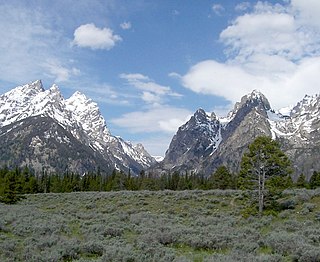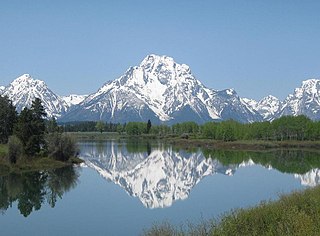
Jenny Lake is located in Grand Teton National Park in the U.S. state of Wyoming. The lake was formed approximately 12,000 years ago by glaciers pushing rock debris which carved Cascade Canyon during the last glacial maximum, forming a terminal moraine which now impounds the lake. The lake is estimated to be 256 feet (78 m) deep and encompasses 1,191 acres (482 ha). Jenny Lake is considered to be a major focal point in Grand Teton National Park, with many hiking trails, scenic boat rides, and quick access to the major climbing routes onto the tallest peaks of the Teton Range.

Cascade Canyon is located in Grand Teton National Park, in the U.S. state of Wyoming. The canyon was formed by glaciers which retreated at the end of the last glacial maximum approximately 15,000 years ago. Today, Cascade Canyon has numerous polished glacial erratics, hanging cirques and a U-shape as evidences that demonstrate that glaciers once filled the canyon to a depth of at least 2,000 feet (610 m). Rock debris that was transported out of the canyon by glacial motion formed moraines which now impound the waters of Jenny Lake which is located at the base of the canyon. Cascade Creek now flows where the glaciers once did and the numerous waterfalls, such as the 100-foot (30 m) tall Hidden Falls, found within the gorge are popular destinations with tourists.

Leigh Lake is located in Grand Teton National Park, in the U. S. state of Wyoming. The glacially formed lake is 2.4 miles (3.9 km) wide and 2.8 miles (4.5 km) long from north to south. Situated just southeast of Mount Moran, the lake is at the terminus of both Paintbrush and Leigh Canyons. The lake can be accessed from the Leigh Lake Trail which follows the eastern shores of String Lake a distance of one mile (1.6 km) and is an easy hike over level terrain. The Leigh Lake Ranger Patrol Cabin is located on the northeast shore of the lake and is on the National Register of Historic Places.

Granite Canyon is located in Grand Teton National Park, in the U. S. state of Wyoming. The canyon was formed by glaciers which retreated at the end of the last glacial maximum approximately 15,000 years ago, leaving behind a U-shaped valley. The canyon lies between Rendezvous Mountain to the south and Mount Hunt to the north. The trailhead for the canyon is on the Moose–Wilson Road about 2 miles (3.2 km) north of Teton Village. One of the most popular hikes from the trailhead is to Marion Lake by way of the Granite Canyon Trail which traverses the length of the canyon. Another popular hike involves riding the aerial tram located at the Jackson Hole Mountain Resort in Teton Village to the top of Rendezvous Mountain, and then descending back to Teton Village by way of Granite Canyon. The descent from the summit of Rendezvous Peak back to Teton Village is an often steep one with an altitude loss of 4,100 feet (1,200 m). The historic Upper Granite Canyon Patrol Cabin is situated near the entrance to the canyon and was listed on the National Register of Historic Places in 1998.

Signal Mountain is an isolated summit standing 7,720 feet (2,350 m) above sea level. The mountain is located in Grand Teton National Park in the U.S. state of Wyoming. The next closest higher summit is more than 10 miles (16 km) distant, and this isolation provides sweeping views of the Teton Range, much of the northern Jackson Hole area as well as the Snake River. Though located adjacent to the Tetons, Signal Mountain was not formed in the same manner or period. The mountain originally was formed by volcanic ashfall from one of the eruptions of the Yellowstone hotspot. The peak is also partially a glacial moraine formed by a receding glacier that came south out of the Yellowstone icecap. This same glacier also created neighboring Jackson Lake.

Ranger Peak is in the northern Teton Range, Grand Teton National Park, Wyoming. The peak is located slightly northwest of and across Jackson Lake from Colter Bay Village. Colter Canyon is to the north while Waterfalls Canyon is immediately southeast of the peak, but there are no maintained trails in the area. Access to the summit involves off trail hiking and scrambling. The top of the mountain is more than 4,500 feet (1,400 m) above Jackson Lake.

Garnet Canyon is located in Grand Teton National Park in the U.S. state of Wyoming. The canyon was formed by retreating glaciers which reached their last glacial maximum around 15,000 years ago. While Garnet Canyon is a less popular destination for recreational hikers than nearby Cascade Canyon or Death Canyon, it is an important approach to many significant and popular mountaineering climbs including routes found on Grand Teton, Middle Teton, South Teton and Disappointment Peak.

Paintbrush Canyon is located in Grand Teton National Park, in the U. S. state of Wyoming. The canyon was formed by glaciers which retreated at the end of the last glacial maximum approximately 15,000 years ago. The canyon lies between Rockchuck Peak and Mount Saint John to the south and Mount Woodring to the north. Leigh Lake is at the base of the canyon to the east and the alpine Holly Lake is located mid canyon. Popular with hikers, the canyon is part of a popular circuit hike of 19.2 miles (30.9 km) which is rated as very strenuous and includes a total elevation change of 3,845 feet (1,172 m) due to the ascent to Paintbrush Divide 10,720 feet (3,270 m). Views from Paintbrush Divide include Lake Solitude and of Mount Moran to the north and the Cathedral Group including Grand Teton to the south. An ice axe may be necessary for hikes in the early summer. The Paintbrush Canyon Trail is part of the Teton Crest Trail, which spans the southern section of the Teton Range from Teton Pass along Wyoming Highway 22 to String Lake, a total distance of 39 miles (63 km).

Moran Canyon is located in Grand Teton National Park, in the U. S. state of Wyoming. The canyon lies between Mount Moran to the south and Traverse Peak and Bivouac Peak to the north. Moran Bay, part of Jackson Lake, is at the mouth of the canyon to the east. The canyon was formed by glaciers which retreated at the end of the last glacial maximum approximately 15,000 years ago.

Webb Canyon is located in Grand Teton National Park, in the U. S. state of Wyoming. The canyon was formed by glaciers which retreated at the end of the last glacial maximum approximately 15,000 years ago, leaving behind a U-shaped valley. Webb Canyon is south of Owl Peak and the entrance to the canyon is near the northern reaches of Jackson Lake. Moose Creek flows through much of the 9 miles (14 km) long canyon and the Webb Canyon Trail traverses the length of the canyon to Moose Basin Divide.
Colter Canyon is located in Grand Teton National Park, in the U.S. state of Wyoming. The canyon was formed by glaciers which retreated at the end of the last glacial maximum approximately 15,000 years ago, leaving behind a U-shaped valley. Colter Canyon is north of Ranger Peak and the entrance to the canyon is along the northwestern shore of Jackson Lake.

Waterfalls Canyon is located in Grand Teton National Park, in the U. S. state of Wyoming. The canyon was formed by glaciers which retreated at the end of the last glacial maximum approximately 15,000 years ago, leaving behind a U-shaped valley. Waterfalls Canyon is south of Ranger Peak and north of Eagles Rest Peak and the entrance to the canyon is along the western shore of Jackson Lake, directly across the lake from the Colter Bay Village. There are several cascades in the canyon, including Wilderness Falls and Columbine Cascade, which descend from an unnamed lake below Ranger Peak.

Snowshoe Canyon is located in Grand Teton National Park, in the U. S. state of Wyoming. The canyon was formed by glaciers which retreated at the end of the last glacial maximum approximately 15,000 years ago, leaving behind a U-shaped valley. Snowshoe Canyon splits into an upper and lower canyon. The source of the upper canyon is near Talus Lake while the south canyon is situated between Rolling Thunder Mountain to the north and Raynolds, Traverse and Bivouac Peaks to the south. Near the fork of north and south Snowshoe Canyon lies Dudley Lake. The canyon terminus is at Moran Bay on the southwest side of Jackson Lake, below Eagles Rest Peak.

Leigh Canyon is located in Grand Teton National Park, in the U. S. state of Wyoming. The canyon was formed by glaciers which retreated at the end of the last glacial maximum approximately 15,000 years ago, leaving behind a U-shaped valley. Leigh Canyon is approximately 6 miles (9.7 km) long and is flanked by Mount Moran and Thor Peak to the north and Mount Woodring to the south. The canyon outlet is at Leigh Lake and at the head of the canyon lies Mink Lake.

Hanging Canyon is located in Grand Teton National Park, in the U. S. state of Wyoming. The canyon was formed by glaciers which retreated at the end of the last glacial maximum approximately 15,000 years ago, leaving behind a U-shaped valley. Hanging Canyon is south of Mount Saint John and north of Symmetry Spire. The canyon is northwest of Jenny Lake and within the canyon lies Lake of the Crags, Ramshead Lake and Arrowhead Pool.
Valhalla Canyon is located in Grand Teton National Park, in the U. S. state of Wyoming. The canyon was formed by glaciers which retreated at the end of the last glacial maximum approximately 15,000 years ago, leaving behind a U-shaped valley. Valhalla Canyon extends from the northwest flanks of Grand Teton and Mount Owen and ends in Cascade Canyon.

Open Canyon is located in Grand Teton National Park, in the U. S. state of Wyoming. The canyon was formed by glaciers which retreated at the end of the last glacial maximum approximately 15,000 years ago, leaving behind a U-shaped valley. Open Canyon is situated between Mount Hunt, Prospectors Mountain and Coyote Lake which are at the head of the canyon. The canyon is accessed by way of the Open Canyon Trail.

Avalanche Canyon is located in Grand Teton National Park, in the U.S. state of Wyoming. The canyon was formed by glaciers which retreated at the end of the last glacial maximum approximately 15,000 years ago, leaving behind a U-shaped valley. To the north of Avalanche Canyon lies South Teton, Cloudveil Dome and Nez Perce Peak while to the southwest lie Mount Wister and Veiled Peak. Snowdrift Lake, Lake Taminah, and Shoshoko Falls are situated at the head of the canyon.
The following articles relate to the history, geography, geology, flora, fauna, structures and recreation in Grand Teton National Park.















